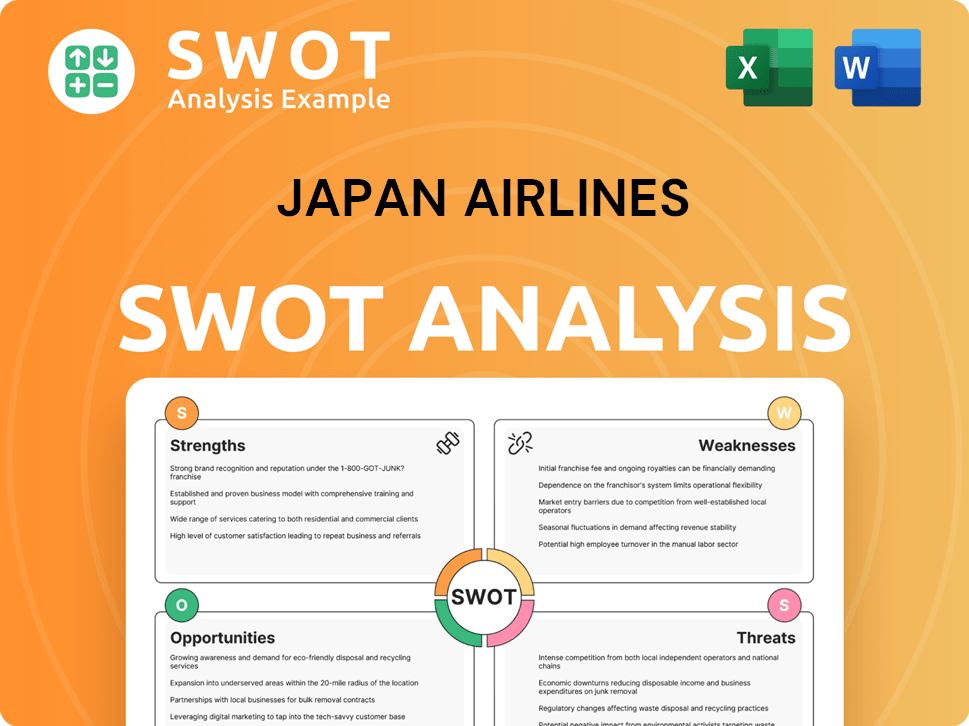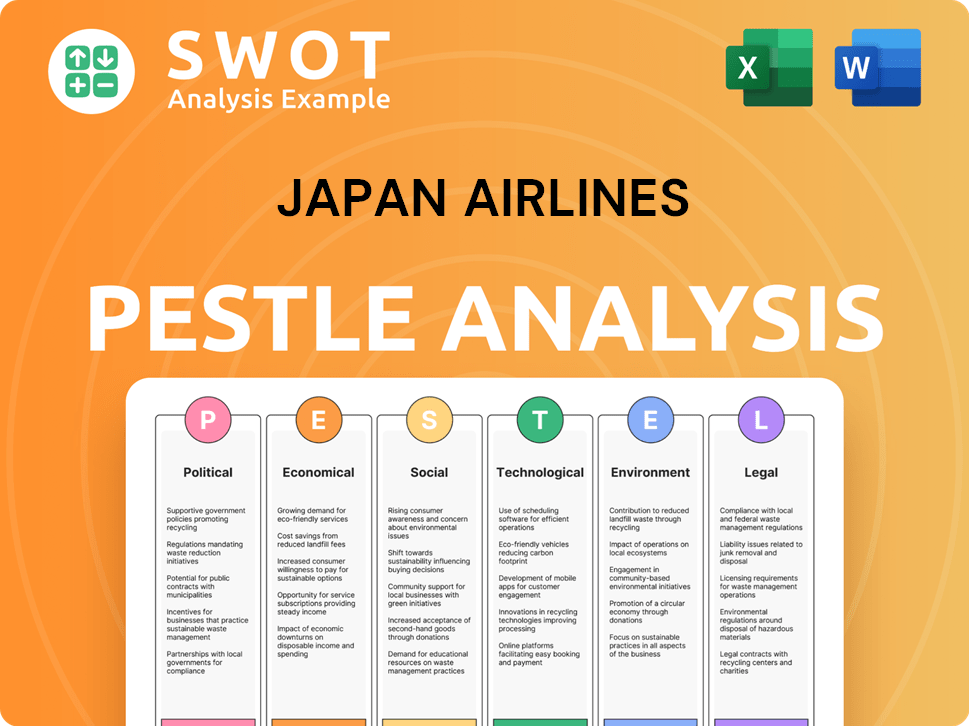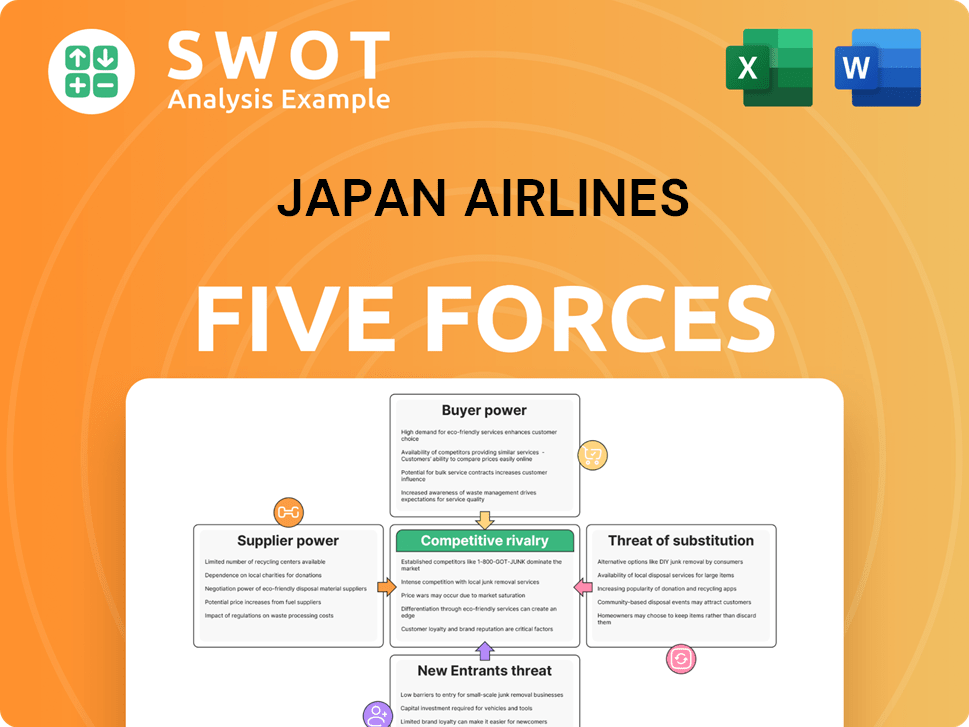Japan Airlines Bundle
How Does Japan Airlines Navigate the Turbulent Skies of Global Aviation?
Japan Airlines (JAL), a cornerstone of the Japanese aviation sector, faces a dynamic and fiercely competitive landscape. From its humble beginnings in 1951, JAL has evolved into a global force, connecting Japan to the world. Understanding its position within this complex environment is crucial for anyone seeking to understand the future of air travel.

The Japan Airlines SWOT Analysis provides a comprehensive overview of JAL's strengths, weaknesses, opportunities, and threats, offering critical insights into its strategic positioning. This analysis explores the competitive landscape of Japan Airlines, examining its rivals and the factors that shape its success. Delving into the airline industry Japan and JAL's market share is essential to understand its current standing and future prospects, including JAL market position 2024 and beyond.
Where Does Japan Airlines’ Stand in the Current Market?
Japan Airlines (JAL) holds a significant market position in both the Japanese and international aviation sectors. As of 2024-2025, JAL, alongside All Nippon Airways (ANA), dominates the Japanese domestic market, offering an extensive network of routes. In the international segment, JAL competes with major global carriers, utilizing its hubs at Narita (NRT) and Haneda (HND) airports in Tokyo. Its core operations include scheduled passenger services, cargo services, and ancillary offerings such as mileage programs.
JAL serves a diverse customer base, from business travelers seeking premium services to leisure travelers looking for competitive fares. The airline has adapted to market demands by introducing flexible fare options and enhancing its digital presence to improve customer experience. JAL's financial health reflects a recovery trajectory post-pandemic, with a focus on optimizing costs and maximizing revenue per available seat kilometer (RASK).
For the fiscal year ending March 31, 2024, JAL reported an operating profit of 130.4 billion yen, demonstrating a strong recovery. This performance highlights its robust recovery and strategic initiatives in a challenging global environment. JAL maintains a particularly strong position on key Asian routes, benefiting from Japan's strong economic ties within the region and its role as a major tourist destination. The airline's strategic focus includes enhancing customer experience and operational efficiency to maintain its competitive edge in the airline industry Japan.
JAL's core operations encompass scheduled passenger services, both domestic and international, cargo services, and ancillary offerings. These include mileage programs and airport lounge access, designed to cater to a wide range of customer needs. The airline leverages its hub operations at Narita (NRT) and Haneda (HND) airports in Tokyo to facilitate efficient connectivity.
The value proposition of JAL centers around providing a blend of premium and flexible services. It caters to both business and leisure travelers, offering a range of fares and enhanced digital experiences. JAL focuses on operational efficiency and customer satisfaction, aiming to maintain a competitive edge in the Japanese aviation market and beyond.
JAL, along with ANA, holds a dominant position in the Japanese domestic market. While specific market share figures for 2024-2025 are subject to ongoing market dynamics, the duopoly structure is a key characteristic. In the international market, JAL competes with major global carriers, focusing on routes to and from Japan.
Historically known for premium services, JAL has adapted by introducing flexible fare options and improving its digital presence. This shift reflects a response to changing market demands and a focus on enhancing customer experience. The airline aims to optimize costs and maximize revenue per available seat kilometer (RASK) to maintain its competitive advantage.
JAL's financial performance reflects a recovery trajectory post-pandemic. The operating profit of 130.4 billion yen for the fiscal year ending March 31, 2024, demonstrates a significant turnaround. This recovery is supported by strategic initiatives focused on cost optimization and revenue generation.
- Focus on key Asian routes, leveraging Japan's economic ties.
- Enhancement of customer experience through digital improvements.
- Strategic fare options to cater to diverse customer segments.
- Ongoing efforts to improve operational efficiency.
Japan Airlines SWOT Analysis
- Complete SWOT Breakdown
- Fully Customizable
- Editable in Excel & Word
- Professional Formatting
- Investor-Ready Format

Who Are the Main Competitors Challenging Japan Airlines?
The Marketing Strategy of Japan Airlines faces a dynamic competitive landscape. This landscape is shaped by both domestic and international players, each vying for market share in the airline industry Japan. Understanding these competitors is crucial for assessing JAL's position and formulating effective strategies.
The Japan Airlines (JAL) operates within a complex environment. This includes full-service carriers, low-cost airlines, and global alliances. The company's ability to navigate this competitive arena directly impacts its financial performance and future growth. Analyzing the strengths and weaknesses of these rivals is key to understanding JAL's market share JAL and overall industry position.
The Japan Airlines competitive analysis reveals a multi-faceted competitive environment. Key players include both domestic and international airlines. These competitors employ various strategies, from route optimization to service differentiation, to attract customers and gain an edge in the market.
ANA is JAL's primary domestic rival. They compete head-to-head on major routes. They both offer full-service options and focus on service quality.
Asian airlines like Korean Air, Cathay Pacific, Singapore Airlines, and China Eastern Airlines are significant competitors. These airlines compete on routes to and from Japan. They often have strong alliances and extensive networks.
European and North American airlines, such as Lufthansa, Air France-KLM, British Airways, United Airlines, Delta Air Lines, and American Airlines, are also key players. They compete on long-haul intercontinental flights. They leverage global networks and alliance partnerships.
LCCs like Peach Aviation (an ANA subsidiary) and Jetstar Japan (a JAL affiliate) provide indirect competition. These airlines offer budget-friendly options. This puts downward pressure on fares, particularly in the leisure travel segment.
The airline industry is heavily influenced by alliances. JAL is part of the oneworld alliance. ANA is part of Star Alliance. These partnerships provide broader networks and enhance competitiveness.
The aviation market is constantly evolving. Mergers, acquisitions, and emerging players from fast-growing markets continually reshape the competitive landscape. Technological advancements and changing customer preferences also play a role.
Several factors influence the competitive dynamics in the Japanese aviation market. These include pricing strategies, route networks, service quality, and brand reputation. Understanding these factors is essential for evaluating JAL's market position 2024.
- Pricing: Competitive pricing is crucial, especially on popular routes.
- Route Networks: Extensive domestic and international networks are essential for reaching a wide customer base.
- Service Quality: High-quality service, including in-flight amenities and customer support, is a key differentiator.
- Brand Reputation: A strong brand reputation fosters customer loyalty and trust.
- Strategic Partnerships: Alliances and partnerships expand reach and enhance competitiveness.
Japan Airlines PESTLE Analysis
- Covers All 6 PESTLE Categories
- No Research Needed – Save Hours of Work
- Built by Experts, Trusted by Consultants
- Instant Download, Ready to Use
- 100% Editable, Fully Customizable

What Gives Japan Airlines a Competitive Edge Over Its Rivals?
Japan Airlines (JAL) holds several key competitive advantages that help it succeed in the airline industry. These advantages are crucial for understanding its market position within the Japanese aviation sector and globally. JAL's focus on customer satisfaction and operational efficiency has helped it maintain a strong position, even amidst challenges.
The airline's strategic moves and commitment to innovation have been essential for its competitive edge. JAL has consistently adapted to market changes, ensuring its services meet evolving customer needs. These efforts have helped it maintain a strong brand reputation and customer loyalty.
Understanding these advantages is vital for anyone analyzing the Target Market of Japan Airlines and its competitive landscape. These factors contribute to JAL’s ability to compete effectively in a dynamic global market.
JAL benefits from a well-established brand, known for safety and quality service. This reputation fosters customer loyalty, especially among Japanese travelers. It is a significant advantage in a competitive market, influencing customer choice and repeat business.
JAL's comprehensive domestic network serves as a crucial feeder system for its international flights. This network provides seamless connectivity for passengers, enhancing convenience and making JAL a preferred choice for both domestic and international travel. This is a key factor in its market share.
Membership in the Oneworld alliance expands JAL's global reach and connectivity. This partnership offers passengers a wider array of destinations, shared lounge access, and reciprocal mileage benefits. This enhances JAL's competitiveness against airlines from other alliances.
JAL invests in a modern, fuel-efficient fleet, which improves operational efficiency and reduces its environmental footprint. This aligns with growing consumer and regulatory demands for sustainability. This also helps to lower operating costs.
JAL continually improves the customer experience through digital enhancements. This includes improvements in online booking, check-in processes, and in-flight entertainment. These innovations are critical for staying competitive in the modern airline industry.
- Customer Satisfaction: JAL consistently focuses on improving customer satisfaction through various service enhancements and digital tools.
- Operational Efficiency: The airline's commitment to operational efficiency helps it manage costs effectively.
- Strategic Partnerships: JAL forms strategic partnerships to enhance its network and service offerings.
- Market Adaptation: JAL adapts to market changes, ensuring its services meet evolving customer needs.
Japan Airlines Business Model Canvas
- Complete 9-Block Business Model Canvas
- Effortlessly Communicate Your Business Strategy
- Investor-Ready BMC Format
- 100% Editable and Customizable
- Clear and Structured Layout

What Industry Trends Are Reshaping Japan Airlines’s Competitive Landscape?
The Growth Strategy of Japan Airlines is significantly influenced by industry trends, future challenges, and opportunities within the dynamic Japanese aviation market. The airline industry in Japan is currently navigating through technological advancements, evolving consumer preferences, and geopolitical uncertainties, all of which shape JAL's strategic direction and operational decisions. Understanding these factors is crucial for assessing JAL's competitive landscape and future prospects.
JAL's position is also affected by its financial performance, market share, and strategic partnerships. The company's ability to adapt to market changes, manage costs, and innovate its services will determine its success. JAL faces a complex environment with both internal strengths and external challenges, requiring careful navigation to maintain and enhance its market position.
The airline industry in Japan is currently experiencing several key trends. Sustainable aviation fuels (SAFs) and fuel-efficient aircraft are becoming increasingly important, providing opportunities to reduce environmental impact. Consumer demand is shifting towards personalized travel experiences, digital convenience, and sustainable options. These trends require airlines to adapt their strategies.
JAL faces several challenges. These include the high costs associated with SAF production and fleet modernization. Meeting diverse consumer expectations while maintaining cost efficiency is also a challenge. Geopolitical shifts and global economic uncertainties, such as fluctuating fuel prices, could impact international travel demand and profitability.
There are also several opportunities for JAL. These include enhancing digital platforms and tailoring service offerings to attract environmentally conscious travelers. Growth opportunities also exist in emerging markets, particularly within Asia. Strategic partnerships could further expand JAL's network and market reach.
To remain competitive, JAL is likely to focus on cost optimization, fleet modernization, digital transformation, and sustainable aviation practices. The airline is also expected to enhance its premium cabin offerings and explore specialized travel packages. Strategic partnerships beyond the Oneworld alliance could also be pursued.
The competitive landscape for Japan Airlines is shaped by various factors, including market share, financial performance, and strategic partnerships. The airline industry in Japan is influenced by global events, economic conditions, and consumer preferences. JAL's ability to adapt to these changes will be critical.
- Market Share: In 2024, JAL and its main competitor, All Nippon Airways (ANA), continue to dominate the Japanese aviation market. JAL holds a significant market share, but faces competition from ANA and other international carriers.
- Financial Performance: JAL's financial performance is influenced by fuel prices, currency exchange rates, and passenger demand. The airline's ability to manage costs and generate revenue is crucial for its profitability.
- Strategic Partnerships: JAL's partnerships with other airlines, including the Oneworld alliance, are essential for expanding its network and providing services to customers. These partnerships help JAL compete more effectively in the global market.
- Sustainability: The adoption of SAFs and investment in fuel-efficient aircraft are important for reducing the environmental impact of JAL's operations. This is also a key factor in attracting environmentally conscious travelers.
Japan Airlines Porter's Five Forces Analysis
- Covers All 5 Competitive Forces in Detail
- Structured for Consultants, Students, and Founders
- 100% Editable in Microsoft Word & Excel
- Instant Digital Download – Use Immediately
- Compatible with Mac & PC – Fully Unlocked

Related Blogs
- What are Mission Vision & Core Values of Japan Airlines Company?
- What is Growth Strategy and Future Prospects of Japan Airlines Company?
- How Does Japan Airlines Company Work?
- What is Sales and Marketing Strategy of Japan Airlines Company?
- What is Brief History of Japan Airlines Company?
- Who Owns Japan Airlines Company?
- What is Customer Demographics and Target Market of Japan Airlines Company?
Disclaimer
All information, articles, and product details provided on this website are for general informational and educational purposes only. We do not claim any ownership over, nor do we intend to infringe upon, any trademarks, copyrights, logos, brand names, or other intellectual property mentioned or depicted on this site. Such intellectual property remains the property of its respective owners, and any references here are made solely for identification or informational purposes, without implying any affiliation, endorsement, or partnership.
We make no representations or warranties, express or implied, regarding the accuracy, completeness, or suitability of any content or products presented. Nothing on this website should be construed as legal, tax, investment, financial, medical, or other professional advice. In addition, no part of this site—including articles or product references—constitutes a solicitation, recommendation, endorsement, advertisement, or offer to buy or sell any securities, franchises, or other financial instruments, particularly in jurisdictions where such activity would be unlawful.
All content is of a general nature and may not address the specific circumstances of any individual or entity. It is not a substitute for professional advice or services. Any actions you take based on the information provided here are strictly at your own risk. You accept full responsibility for any decisions or outcomes arising from your use of this website and agree to release us from any liability in connection with your use of, or reliance upon, the content or products found herein.